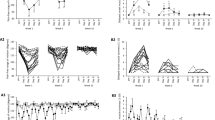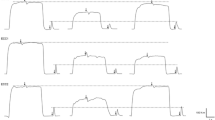Summary
Exercise can cause muscle pain for a number of reasons. Usually the pain is experienced during the exercise and recovers rapidly afterwards. There is one type of muscle pain that has a very different and characteristic time course. In this situation the exercise itself, and the immediate post-exercise period are painfree. The pain is not felt for about eight hours and is maximal 1 or 2 days later. Delayed onset muscle pain occurs after unaccustomed, high force contractions and is particularly associated with eccentric contractions. The concensus of opinion is that the pain is caused by some form of damage, but the mechanism for the pain is not known. This review summarises the literature on the consequences of eccentric contractions and relates them to delayed onset muscle pain. There is clear evidence of damage to the muscle fibres themselves, their membranes and, at a later stage, mononuclear cell infiltration, but all these have very different time courses and none are the same as the pain. Intramuscular pressures are raised in some, but not all, painful compartments and even when raised follow a different time course to the pain. Anti-inflammatory agents do not affect the pain, but due to the incomplete understanding of the action of these drugs, the role of inflammation in delayed onset muscle pain is uncertain.
Despite the considerable evidence of damage after eccentric contractions, the cause of delayed onset muscle pain is still unknown.
Similar content being viewed by others

References
Abbott BC, Bigland B, Ritchie JM (1952) The physiological cost of negative work. J Physiol 117:380–390
Abraham WM (1977) Factors in delayed muscle soreness. Med Sci Sports 9:11–26
Armstrong RB (1984) Mechanisms of exercise-induced delayed onset muscular soreness: a brief review. Med Sci Sport Exerc 16:529–538
Armstrong RB, Oglivie RW, Schwane JA (1983) Eccentric exercise induced injury in rat skeletal muscle. J Appl Physiol 54:80–93
Asmussen E (1953) Positive and negative muscular work. Acta Physiol Scand 28:364–382
Asmussen E (1956) Observations on experimental muscular soreness. Acta Rheum Scand 2:109–16
Bellina CR, Bianchi R, Bombardieri S, Feni C, Mariani G, Muratoria A, Rossi B, Picchi L (1978) Quantitative evaluation of 99m TC pyrophosphate muscle uptake in patients with inflammatory and non-inflammatory muscle diseases. J Nucl Med 22:89–96
Berg A, Haralambie G (1978) Changes in serum creatine kinase and hexose phosphate isomerase activity with exercise duration. Eur J Appl Physiol 39:191–201
Brendstrup P (1962) Late edema after muscular exercise. Arch Physiol Med Rehab 43:401–405
Brill DR (1981) Radionuclide imaging of non-neoplastic soft tissue disorders. Semin Nucl Med 11:277
Brooke MH, Caroll JE, Davis JE, Hagberg JM (1979) The prolonged exercise test. Neurology 29:636–643
Bulke JAL, Baert AC (1982) Clinical and radiological aspects of myopathies. Springer, Heidelberg Berlin New York
Davies CTM, Barnes C (1972) Negative (eccentric) work. II. Physiological responses to walking uphill and downhill on a motor-driven treadmill. Ergonomics 15:121–131
Davies CTM, White MJ (1981) Muscle weakness following eccentric work in man. Pflügers Arch 392:168–171
Dubovitz V, Roy S (1970) Central core disease of muscle: Clinical, histochemical and electron microscopic studies of an affected mother and child. Brain 93:133–146
Fischman DA, Meltzer HY, Poppei RW (1973) The ultrastructure of human skeletal muscle: variations from archetypal morphology. In: Pearson CM, Mostofi EK (eds) The striated muscle. Williams and Wilkins, Baltimore, pp 58–79
Friden J (1983) Exercise induced muscle soreness. PhD thesis. Umea University Medical Dissertations, New Series 105, Sweden
Friden J (1984) Changes in human skeletal muscle induced by long-term eccentric exercise. Cell Tiss Res 236:365–372
Friden J, Sfakianos PN, Hargens AR (1986) Delayed muscle soreness and intramuscular fluid pressure: comparison between eccentric and concentric load. J Appl Physiol 61:2175–2179
Friden, J, Sjostrom M, Ekblom B (1981) A morphological study of delayed muscle soreness. Experientia 37:506–7
Friden J, Sjostrom M, Ekblom B (1983) Myofibrillar damage following intense eccentric exercise in man. Int J Sports Med 4:170–76
Giraldi C, Mariani G, Molea N, Rossi B (1979) 99m TC-pyrophosphate muscle uptake in four subjects with Becker's disease. J Nucl Med Allied Sci 23:45–47
Graves J, Clarkson PM, Kirwan J, Litchfield P (1984) Serum creatine kinase levels following three different isometric exercise regimes. Med Sci Sports Exerc 16:186–187
Hill AV (1951) Mechanics of voluntary muscle. Lancet 2:947–951
Headley SA, Newham DJ, Jones DA (1986) The effect of prednisolone on exercise induced muscle pain and damage. Clin Sci 70:85P
Hough T (1902) Ergographic studies in muscular soreness. Am J Physiol 7:76–92
Janssen E, Kuipers H, Verstappen F, Costill D (1983) Influence of an anti-inflammatory drug on muscle soreness. Med Sci Sports Exerc 15:165
Jones DA, Newham SD, Clarkson PM (1987) Skeletal muscle stiffness and pain following eccentric exercise of the elbow flexors. Pain 30:233–242
Jones DA, Newham DJ, Round JM, Tolfree SEJ (1986) Experimental human muscle damage: morphological changes in relation to other indices of damage. J Physiol 375:435–448
Knuttgen HG, Bonde-Peterson F, Klausen K (1971) O2 uptake and heart rate responses to exercise performed with concentric and eccentric muscle contractions. Med Sci Sports 3:1–5
Komi PV (1973) Relationship between muscle tension, EMG and velocity of contraction under concentric and eccentric conditions. In: Desmedt J (ed.) New developments in electromyography and clinical neurophysiol, vol I. Karger, Basel, pp 596–606
Komi PV, Buskirk ER (1972) Effect of eccentric and concentric muscle conditioning on tension and electrical activity of human muscle. Ergonomics 15:417–34
Komi PV, Rusko O (1974) Quantitative evaluation of mechanical and electrical changes during fatigue loading of eccentric and concentric work. Scand J Rehab Med [Suppl] 3:121–126
Kuipers H, Keizer HA, Verstappen FTJ, Costill DL (1983) Influence of a prostaglandin inhibiting drug on muscle soreness after eccentric work. Int J Sports Med 6:336–339
Lentle BC, Percy JS, Regal WM (1978) Localisation of TC-99m pyrophosphate in muscle after exercise. J. Nucl Med 19:223–224
Lewis T (1942) Pain. Macmillan, London
Margaria R (1968) Positive and negative work performance and their efficiencies in human locomotion. Int Z Angew Physiol 25:339–351
Matin P, Lang G, Garetta R, Simon G (1983) Scintographic evaluation of muscle damage following extreme exercise. J Nucl Med 24:308–311
Maxwell JH, Bloor CM (1981) Effects of conditioning on exertional rhabdomyolysis and serum creatine kinase after severe exercise. Enzyme 26:177–181
Meltzer HY, Kund RW, Click J, Yang V (1976) Incidence of Z band streaming and myofibrillar disruptions in skeletal muscle from healthy young people. Neurology 26:853–857
Messina C, Bonanno N, Vita G (1978) Radio isotope scanning with TC 99m labelled phosphate complex in neuromuscular disease. Boll Soc Ital Sper 54:2457–2461
Mills KR, Newham DJ, Edwards RHT (1982) Force, contraction frequency and energy metabolism as determinants of ischaemic muscle pain. Pain 14:149–164
Mubarak SJ (1981) Exertional compartment syndromes. In: Mubarak SJ, Hargen's (eds) AR Compartment syndromes and Volkman's contracture. WB Saunders London, pp 209–226
McGlynn GH, Laughlin NT, Rowe V (1979) Effect of electromyographic feedback and static stretching on artificially induced muscular soreness. Am J Physiol Med 58:139–148
Mclean AEM (1977) Abnormal localisation of Gallium 67 citrate in pseudohyperthrophic muscular dystrophy. Lancet II:180
Newham DJ, Jones DA (1985) Intra-muscular pressure in the painful human biceps. Clin Sci 69:27P
Newham DJ, Jones DA, Edwards RHT (1983c) Large delayed plasma creatine kinase changes after stepping exercise. Muscle Nerve 6:380–385
Newham DJ, Jones DA, Edwards RHT (1986a) Plasma creatine kinase changes after eccentric and concentric contractions. Muscle Nerve 9:59–63
Newham DJ, Jones DA, Edwards RHT (1986b) Plasma creatine kinase changes after eccentric and concentric contractions. Muscle Nerve 9:59–63
Newham DJ, Jones DA, Tolfree SEJ, Edwards RHT (1986) Skeletal muscle damage: a study of isotope uptake, enzyme efflux and pain after stepping. Eur J Appl Physiol 55:106–112
Newham DJ, Mills KR, Quigley BM, Edwards RHT (1983a) Pain and fatigue following concentric and eccentric muscle contractions. Clin Sci 64:55–62
Newham DJ, McPhail G, Mills KR, Edwards RHT (1983b) Ultrastructural changes after concentric and eccentric contractions. J Neurol Sci 61:109–122
Pennington RJT (1981) biochemical aspects of muscle disease. In: Walton JN (ed.) Disorders of voluntary muscle. 4th Edition. Churchill Livingstone, Edinburgh, pp 417–444
Robinson GP, Battaglia DJ (1975) Technetium-99m-tetracycline-preparation, biological dynamics and uptake in damaged and normal skeletal muscle. Int J Appl Rad Isotop 26:147–152
Rodbard S, Pragay EB (1968) Contraction frequency, blood supply and muscle pain. J Appl Physiol 24:142–145
Spies SM, Swift TR, Brown M (1975) Increased 99m TC polyphosphonate muscle uptake in a patient with polymyositis. J Nucl Med 16:1125–1127
Swift TR, Brown M (1978) TC 99m pyrophosphate muscle labelling in McArdles Syndrome. J Nucl Med 19:295–297
Valk P (1984) Muscle localisation of TC-99m MDP after exertion. Clin Nucl Med 9:493–494
Vita G, Harris JB (1981) The uptake of 99m Technetium diphosphonate into degenerating and regenerating muscle. J Neurol Sci 51:339–354
Vries de HA (1966) Quantitative EMG investigation of the spasm theory of muscle pain. Am J Physiol Med 45:119–134
Author information
Authors and Affiliations
Rights and permissions
About this article
Cite this article
Newham, D.J. The consequences of eccentric contractions and their relationship to delayed onset muscle pain. Europ. J. Appl. Physiol. 57, 353–359 (1988). https://doi.org/10.1007/BF00635995
Accepted:
Issue Date:
DOI: https://doi.org/10.1007/BF00635995



